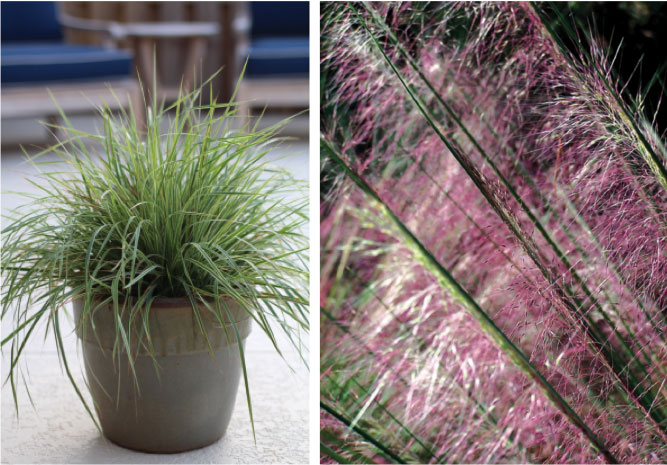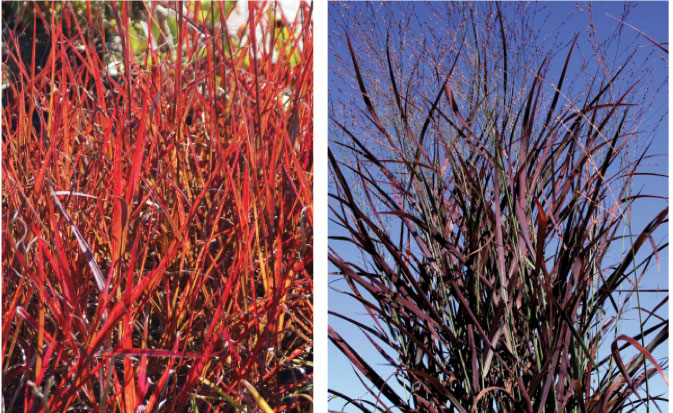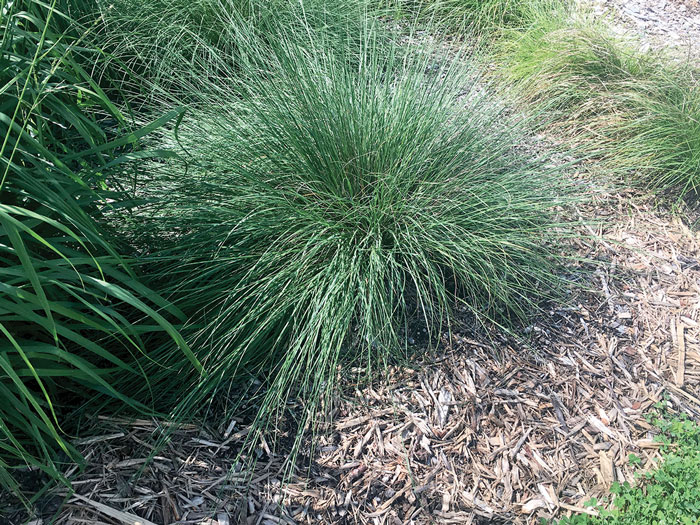1/1/2020
Overcoming Grass Fatigue
Josiah Raymer

When perennials burst onto the scene a couple of decades ago (we all knew about them, but the public finally got wise), ornamental grasses earned just a footnote or afterthought. As breeders began to play around with genetics and work harder at selection from the species, interest in the grasses was piqued among the masses.
Pictured left: Calamagrostis xacutiflora Hello Spring! is similar to Overdam, but cleaner and lighter.
Right: Muhlenbergia Fast Forward flowers before the frost—much earlier than the species and other varieties
Looking for low-maintenance lookers that deliver instant gratification? Turns out ornamental grasses fit the bill perfectly. Just pop a few in the landscape, establish them and you’re set. Fast forward, and now we’re looking for some more creative choices for us and our customers. Breeders have been hard at work again, and we’ve been just as diligently testing them in our own trial gardens and greenhouses. Here are a few of our new favorites if you’re looking for alternatives to the grass standards:
• Calamagrostis xacutiflora Hello Spring! is similar to Overdam, but cleaner and lighter. I really like the variegated color and it’s a brighter white. It has stronger, more stable variegation.
• If you’re looking for a big bluestem that really stands out from the species, Blackhawks is a really big, dark andropogon that turns deep purple in the fall—a really cool plant. It’s a native that has ornamental value. The color just makes it stand out. Red October is another andropogon that has some really impactful color. Its ornamental value makes it a great choice. It has similar breeding to Blackhawks with more red in its hue.
• Muhlenbergia Undaunted is a great seed variety with showy glistening flower spikes—a great “see-through” planting. It’s a warm season grass that you grow similar to other muhlys. It has really attractive softer, flatter leaves and great flowers. Plus, it’s hardier than most of the genus—it can survive winters as cold as Zone 5!
• Muhlenbergia Fast Forward flowers before the frost—much earlier than the species and other varieties. Flowering begins in August (late July in warm climates). It also has a more refined shape than other muhlys, with tufts of purple flowers above symmetrical, compact mounds of fine, flat foliage.
• Panicums are a big interest of late and varieties like Hot Rod are kind of their own beast—unlike anything else, which makes them really appealing when you’re looking for a change from the norm. Hot Rod is small and upright, but its real appeal is the red tones that appear far earlier than other switch grasses—firmly upright blades emerge blue/green, reddening rapidly until the whole plant is rich, deep maroon.
 Pictured left: Panicum Hot Rod reddens far earlier than others and the species.
Pictured left: Panicum Hot Rod reddens far earlier than others and the species.
Right: Andropogon Red October makes a great alternative to the species with its rich red fall color.
• Sticking with panicums but completely switching gears, Bad Hair Day isn’t to be missed. Use it in place of bigger miscanthus, especially if you’re looking for a native that’s larger, but still upright. Its mophead inflorescences are denser than any other switch grass and they cascade over equally cascading yellow-green pendulous leaves. It’s very interesting-looking, to say the least, and also makes a great focal point or specimen.
• If you’re looking for something to suit the Millennials’ small spaces and every gardener’s need to maximize space, Schizachyrium scoparium Standing Ovation is a good alternative to smaller miscanthus—a really good, mid-size bluestem that maxes out at about 4 ft. It’s very upright and looks very tidy. It presents nice, tall, thick blades and stays nice and clean even when others bend, thanks to sturdy stems. Great color, too, starting out blue-green and turning fiery scarlet for fall.
• We’ve also seen a ton of work on infertile grasses as an option for the self-seeding that frustrates some areas. In particular, we like the group of Pennisetum alopecuroides that are coming out of the University of Georgia’s program. With clever Southern monikers, they’re as fun to say as they are to grow. Jambalaya has long-lasting pink-silver plumes; Praline features soft taupe seed heads; Etouffee offers brownish-pink foxtails; Cayenne stuns with rich red bottlebrush plumes; and Hush Puppy has pink plumes with serious staying power.

Culture notes
In general, most of these grasses won’t need any special treatment—they’ll slide right into your program without an adjustment to your production cycle, fertilizer, light or water. All these grasses like bright light and full sun. We suggest a fungicide drench after liner transplant, then following a monthly broad-spectrum fungicide control program as a preventive measure.
Pictured: Muhlenbergia Undaunted outdoes the rest—it can survive to Zone 5!
One note for panicums: They start to go to sleep early in the fall as the days grow shorter, so make sure they’re finished before they go dormant. They tend to follow their own schedule and aren’t waiting around on yours. It will be before other warm-season grasses like miscanthus, so you may want to bump your production schedule up a little. They’ll overwinter better and you’ll have less loss if they’re fully finished. GT
Josiah Raymer is head grower and general manager for Emerald Coast Growers, one of the country’s largest ornamental grass and perennial liner producers.